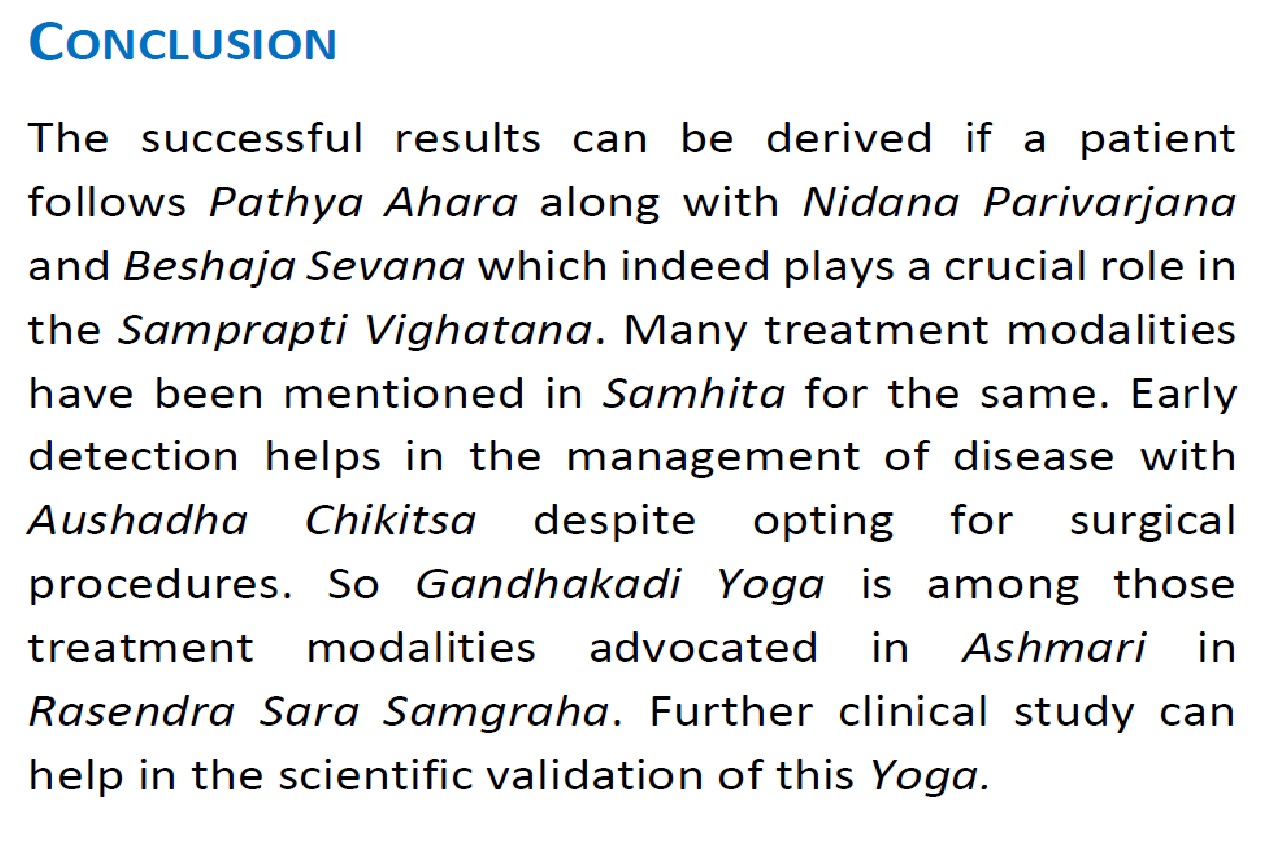Role of Gandhakadi Yoga in the management of Mutrashmari - A conceptual study
Keywords:
Ayurveda, Mutrashmari, Urolithiasis, Ashtamahagada, Gandhakadi YogaAbstract
Ashmari is one of the Mutravahasrotho Vikara. Acharya Sushruta has mentioned it as one among Astamahagada due to its complications to urinary system and also it is difficult to treat and also Sushruta calls it as “Antakapratima” which means Swaroopa of Yama, because of its severe pain. In Ayurvedic literature Bheda of Mootrashmari is based on Lakshana’s of Dosha & Ashma. Due to its features like dysuria, pain abdomen, haematuria and malaise in contemporary science it has been correlated to urolithiasis. Urolithiasis is 3rd most common affliction of urinary tract. The recurrence rate of urolithiasis is approximately 50% within 5 yrs. Renal calculi affects one in 20 at some time or other in their lives to a negligible or noticeable extent. Conservative management of contemporary sciences are not that much helpful in preventing recurrences and surgical management is quite expensive and invasive. In Ayurveda, many Kalpas have been explained for the same and one among is Gandhakadi yoga. So this study has been taken up to explore the effect of Gandhakadi Yoga in Mutrashmari.
Downloads
References
Murthy Prof.K.R.Srikantha, Susruta Samhita of Maharshi Sushruta, Vol-1, Varanasi; Chaukhamba Orientalia; 2012, p-Su. 233.
Rasendra Sara samgraha of Gopala krishnabhatta – Author: Parimi Suresh, Edition – 2007, Chaukhambha Sanskrit Sansthan, 2nd chapter, Shloka no.9, Pg.No. 735.
Sharma P. V., Sharma Guru Prasad, Kaiyadeva Nighantu, Oshadhi Varga/1184-1188, Reprint 2009, Chaukhamba Orientalia, Varanasi.
Anti-urolithiatic and Antioxidant activity of fruit extract of Cuminum cyminum linn in rats” by Mrs.Abbu Jayasudha, St. John’s Pharmacy College, Vijaynagar, Bangalore-2011.
D.K. Kamat, Studies on Medicinal Plants & Drugs in Dhanvantari Nighantu, Vol-1, Shatapushpadi Varga/ 68-71, p-156, Reprint-2011, Chaukhambha Sanskrit Pratishthan, Delhi.
Antiurolithiatic Effects of Solanum xanthocarpum Fruit Extract on Ethylene-Glycol-Induced Nephrolithiasis in Rats, J Young Pharm. 2012 Jul-Sep; 4(3): 164–170. doi: 10.4103/0975-1483.
Bhavamishra.Bhavaprakasha, Vol. 1. Shrikantha Murthy KR, editor. 2nd ed. Varanasi: Krishnadas Academy; 2001.p.233-234.
Amalaki: A review on functional and pharmacological properties. Dr. Pravin M Bhat, Dr. Hari UmaleandDr. Madhukar Lahankar, Journal of pharmacognasy and phytojournal.















